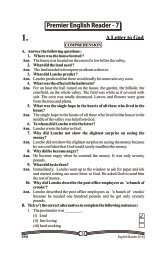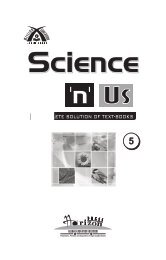Science 'N' us-3 final - School Books Publishers India
Science 'N' us-3 final - School Books Publishers India
Science 'N' us-3 final - School Books Publishers India
Create successful ePaper yourself
Turn your PDF publications into a flip-book with our unique Google optimized e-Paper software.
<strong>Science</strong>'n'UsA COMPLETE SOLUTION OF TEXT-BOOKS3
1.<strong>Science</strong> 'n' Us - 3THINGS AROUND USExerciseA. Answer the following questions :1. What are natural things? Give two examples.Ans. Some things which are found in nature are called natural things.Examples - mountain, river.2. Are man-made things living or non-living?Ans. All man-made things are non-living things.3. How are living things different from non-living things?Ans.Living things(i) Living things have life inthem.(ii) Living things move fromone place to another.(iii) Living things require foodand water.(iv) All living things breathe.Non-living things(i) Non-living things are lifeless.(ii) Non-living things cannotmove on their own.(iii) Non-living things do not needfood and water.(iv) Non-living things do notbreathe.4. Give one example that shows movement in plants.Ans. When we touch the 'Touch-me-not' plant, it closes its leaves. Thisshows movement in plants.5. How are plants generally born?Ans. Plants produce seeds which form new plants. Most of the plants bornfrom seeds.B. Choose the correct word from side box and fill in the blanks :1. Things made by man are called man-made things. reproduction2. Things which are not made by man are called naturalthings.man-made3. Living things grow in size. sunflower4. Sunflower tends to bend towards sun. natural5. Reproduction means producing young ones. livingC. Write :1. Three man-made things :(a) fan (b) bicycle (c) telephone2. Three natural things :(a) mountain (b) river (c) animals3. Three living things :(a) human (b) bird (c) plant4. Three non-living things :(a) b<strong>us</strong> (b) car (c) televisionHorizon Press42<strong>Science</strong> 'n' Us - 1 to 5
5. Three animals which give birth to their young ones :(a) cat (b) dog (c) crowD. Tick (✓) the correct option :1. To which category do insects belong?(a) living things(b) non-living things(c) man-made things2. How do plants breathe?(a) with the help of lungs(b) with the help of pores on leaves(c) they do not breathe at all3. What did J.C.Bose prove?(a) plants are non-living things(b) plants are natural things(c) plants also experience pleasure and painFlowchartFill up the boxes to complete the flowcharts :(a)Things✓✓✓man-madenaturaltable, chaircars, b<strong>us</strong>esmountainsrivers(b)Thingslivingnon-livingplantsbirdsanimalsbicycle chair tableLet <strong>us</strong> EnjoyEnjoy to search the names of 4 living and 4 non-living things in the maze :Living ThingsG C O M B C O WNon-living Things1. cow R P A S B H D A 1. comb2. snakeA M A N R A S L 2. kite3. grass 3. chair4. man S K P A N I M L 4. panS E R K O R E XK I T E L P H THorizon Press43<strong>Science</strong> 'n' Us - 1 to 5
Fun Time Activity1. Make a chart of things around <strong>us</strong> and classify them into living and nonlivingcategories.Ans. Do yourself.2. Put two small plants in separate pots. Cover one plant with a plastictransparent sheet. Put both the plants in sunlight. Provide water andnutrients to both the plants. Observe the plants after a few days. Disc<strong>us</strong>sthe consequences with your science teacher.Ans. Do yourself.2.PARTS OF A PLANTExerciseA. Answer the following questions :1. What are the different parts of a plant?Ans. There are seven main parts of a plant. They are roots, stem, branches,leaves, fruits, flowers and seeds.2. What do you mean by shoot?Ans. The part of the plant which is above the soil is called the shoot.3. Name vario<strong>us</strong> parts of a leaf.Ans. The flat and broad part of a leaf is called theleaf blade or the lamina. In the middle of theleaf is the main vein. A number of side veinsarise from the main vein. The stalk of theleaf is called petiole. There are small poresat the lower side of the leaves. These arecalled stomata.4. Why are leaves green?Ans. Leaves are green in colour due to the presence of a pigment calledchlorophyll.5. What is germination?Ans. The growing of a new plant from the parts of old plant is calledgermination.B. Write:1. Two functions of roots :(a) Roots hold the plant firmly to the soil.(b) Roots transport water and minerals from the soil to plant.2. Two functions of stem :(a) Stem keeps the plant erect and firm.(b) Stem bears fruits, branches, flowers, etc.3. Two roots that we eat :(a) turnip(b) beetroot4. Two fruits that we eat :(a) apple(b) papayaHorizon Press44<strong>Science</strong> 'n' Us - 1 to 5
C. Match the following :1. leaf (a) grows into a baby plant2. seed (b) keeps the plant erect and firm3. stem (c) bears leaves, fruits, flowers and sub-branches4. branch (d) protects and nourishes the seed5. fruit (e) makes food for the plantD. Write True or False against the following statements :1. There are hair -like structures on the branches of the roots. True2. The stem of banana plant is thin and weak. False3. There is only one branch on one plant. False4. Chlorophyll is found in roots of plant. False5. Leaves breathe through stomata. TrueFlowchartFill up the boxes to complete the flowcharts :(a)Parts of Plantrootshootleavesbranchesstemflowersfruitsseeds(b)Parts of a Leaflaminamain vein side veins petiolestomataLet <strong>us</strong> Enjoy1. Enjoy to draw a neat labelled diagram to show vario<strong>us</strong> parts of a leaf inyour notebook.Ans. Do yourself.2. Enjoy to write the names of different parts of the given plant :seedbranchflowerfruitleafstemrootsHorizon Press45<strong>Science</strong> 'n' Us - 1 to 5
Fun Time ActivityTake ten leaves of different types. Sort them out on the basis of size.Find out how many leaves are small and how many are big. Mix themagain and now sort them out on the basis of whether their edges aresmooth, wavy or toothed. Similarly, find out in how many differentways you can sort out the leaves.Ans. Do yourself.3.ANIMALS AND THEIR FOOD HABITSExerciseA. Answer the following questions :1. Why do animals need food?Ans. Animals need food to grow and to get energy.2. Which animals are called carnivoro<strong>us</strong>? Give two examples.Ans. Some animals eat the flesh of other animals as their food. Such animalsare called carnivoro<strong>us</strong> animals. For example - lion, jackal.3. What type of teeth do herbivoro<strong>us</strong> have?Ans. Herbivoro<strong>us</strong> animals have sharp and broad front teeth to cut grass,leaves and branches.4. What do you mean by "chewing the cud"?Ans. Cows, buffaloes, sheep, etc swallow their food without chewing it.When they rest, they bring this food back into their mouth and thenchew it well with their grinding teeth. This activity is called "chewingthe cud".5. Give one example of food chain.Ans. Plant is eaten by deer and deer is eaten by lion. This is an example offood chain in nature.B. Choose the correct word from side box and fill in the blanks :1. Giraffe is a herbivoro<strong>us</strong> animal. blood2. Squirrels and rabbits gnaw the food. food chain3. The food chain begins with green plants. giraffe4. Lizards and frogs do not have teeth. gnaw5. Mosquito and lice feed on the blood of other animals. teethC. Write :1. Three animals that chew the cud :(a) cow (b) buffalo (c) sheep2. Three animals that gnaw the food :(a) squirrel (b) rabbit (c) rat3. Three animals that swallow the food as whole :(a) lizard (b) frog (c) chameleon4. Three animals that such the milk from mother's breasts :(a) dog (b) goat (c) catHorizon Press46<strong>Science</strong> 'n' Us - 1 to 5
D. Match the following:1. crow (a) rodent2. lizard (b) cud chewing3. rabbit (c) carnivoro<strong>us</strong>4. lion (d) sticky tongue5. cow (e) omnivoro<strong>us</strong>FlowchartFill up the boxes to complete the flowchart :Animalsherbivoro<strong>us</strong>carnivoro<strong>us</strong>omnivoro<strong>us</strong>cow giraffe dog crowlion tigerLet <strong>us</strong> EnjoyEnjoy to fill the crossword puzzle <strong>us</strong>ing the given clues :Across:1 R1. It gnaws the food.3. Animals that eat both plants and flesh.5. It swallows food as whole.7. It sucks milk from mother's breasts.Down:2. It is a carnivoro<strong>us</strong>.4. It sucks blood from our body.6. It licks the liquid.352A B B I TIGO4M N I V OER O U SLOSQUI Z A R6DTO 7OG O A TFun Time Activity1. Collect pictures of two herbivoro<strong>us</strong>, two carnivoro<strong>us</strong> and twoomnivoro<strong>us</strong> animals and paste them in your scrapbook.Ans. Do yourself.2. Search for any two animals in your neighborhood and write their detailsas :(a) name (b) colour (c) food(d) food habitAns. Do yourself.(e) homeHorizon Press47<strong>Science</strong> 'n' Us - 1 to 5
4.BIRDS : STRUCTURE AND FLIGHTExerciseA. Answer the following questions :1. Name the parts in which the body of a bird can be divided.Ans. Body of a bird can be divided into four major parts- head, abdomen,wings and tail.headwingsabdomentail2. What do you know about the shape of a bird?Ans. Body of the bird is light, thin and boat-shaped which helps in flight. Thebones in the body of a bird are very few and are thin and hollow. Thelight weight of bones helps the bird in flying. The two wings of the birdhelp in flying and regulating its speed. The tail of a bird <strong>us</strong>eful inchanging the direction of flight. The m<strong>us</strong>cles ca<strong>us</strong>e movements inwings and th<strong>us</strong> enable flying.3. Write two qualities of bones of a bird.Ans. (i) The light weight of bones of a bird helps the bird in flying.(ii) The bones of a bird are very strong despite being thin and hollow.4. What is the role of tail in bird's body?Ans. The tail of a bird helpful in changing the direction of birds flight.5. Which birds are called flightless birds and why?Ans. Ostrich, kiwi and penguin are some flightless birds. These birds cannotfly due to their heavy weight.B. Choose the correct word from side box and fill in the blanks :1. Bones of the bird are hollow. wings2. Wings help in flying. tail3. Tail gives direction while flying. hollow4. Birds fly in air. air5. Body of the bird can be divided into four major parts. fourC. Write :1. Two birds which cannot fly :(a) ostrich(b) penguin2. Two birds which fly at great heights and for longer distances :(a) eagle(b) hawk3. Two birds which fly for very short distances :(a) peacock(b) hen4. Two birds which fly at low heights but for longer distances :(a) pigeon(b) parrotHorizon Press48<strong>Science</strong> 'n' Us - 1 to 5
FlowchartFill up the boxes to complete the flowcharts :(a)Body of a Birdheadabdomenwingstail(b)Flight of Birdslow heightlong distancegreat heightlonger distancesmall heightshort distanceflightlesspigeonsparrowpeacockheneagle hawkostrichLet <strong>us</strong> EnjoyEnjoy to search the names of eight birds in this maze :P A R V R H A W KK U C U A N J G OI N K L M B O H SW A I T K I T E TI M U U C F C N RS P A R R O W D IE A G E I E L H CR C R O W P I K Hkiwi1. HAWK2. KITE3. SPARROW4. CROW5. KIWI6. VULTURE7. OSTRICH8. HENFun Time Activity1. Collect the feathers of as many birds as possible and compile them inyour scrapbook. Also recognise the birds with the help of their feathers.Take a brief description from your science teacher.Ans. Do yourself.2. Draw or paste a picture of any bird of your choice on a chart paper.Collect informations about that bird and write them on the chart paper.Ans. Do yourself.Horizon Press49<strong>Science</strong> 'n' Us - 1 to 5
5.Multiple Choice Questions(Based on chapters 1, 2, 3 and 4)Choose the right option :1. Which of the following is not a characteristic of living things?(a) they grow(b) they breathe(c) they don't get hurt ✓(d) they need food and water2. 'Touch-me-not' is a plant which proves that plants are sensitive.(a) plants grow in size (b) plants are sensitive ✓(c) plants reproduce (d) plants are natural things3. The part of the plant below the ground is root.(a) shoot(b) stem(c) root✓(d) seed4. Leaves are green due to the presence of chlorophyll.(a) stomata(b) lamina(c) leaf blade(d) chlorophyll✓5. Food chain starts from :(a) herbivoro<strong>us</strong> animals ✓(b) green plants(c) carnivoro<strong>us</strong> animals (d) omnivoro<strong>us</strong> animals6. Which one is an example of animals that chew the cud?(a) rabbit(b) dog(c) cow✓(d) lizard7. Which one of the following is a flightless bird?(a) kiwi✓(b) peacock(c) eagle(d) parrot8. Which one of the following fly at great height and for longer distance?(a) penguin(b) pigeon(c) ostrich(d) kite✓BIRDS : BEAKS AND CLAWSExerciseA. Answer the following questions :1. What type of beaks do hunter birds have?Ans. Hunter birds like owl, eagle, hawk, etc have strong, sharp and hooked beaks.2. What is the role of holes in a duck's beak?Ans. The holes in a duck's beak provide exit points for the water that gets intothe mouth along with the food.3. Which birds are called perching birds?Ans. Some birds can even sleep while sitting on the branch and their grip isso firm that they do not fall. This act is known as perching and suchbirds are called perching birds.4. How many toes are there in a single foot of a bird?Ans. A bird has four toes in a single foot.Horizon Press50<strong>Science</strong> 'n' Us - 1 to 5
5. What type of claws and toes do climbing birds have?Ans. Climbing birds like parrot, woodpecker, etc have claws, suited forclimbing up. They have two toes pointing upward and two toes pointingdownward. These toes help them to climb up and to cling to the tree.6. Which type of birds have webbed feet?Ans. The swimming birds like duck and swan have webbed feet. Thesewebbed feet help the bird to p<strong>us</strong>h water back like paddles while swimming.7. How do some birds wade in water?Ans. The legs of wading birds are very long and thin with wide spreadingtoes. They have three toes in front and one at the back. These wide toessave the feet from sinking into the mud.B. Match the following :BirdsBeaks1. hawk (a) short, hard and horny beak2. sparrow (b) curved and hooked beak3. parrot (c) strong, sharp and hooked beak4. duck (d) spoon-like, broad and flat beak5. woodpecker (e) strong, sharp and chisel-shaped beakC. Write :1. Two birds which can swim in water : (a) duck (b) swan2. Two birds which can wade in water : (a) crane (b) stork3. Two birds which feed on flesh : (a) eagle (b) vulture4. Two birds which scratch the ground : (a) hen (b) cockD. Write True or False against the following statements :1. Birds do not have teeth. True2. Beaks and claws of all birds are similar. False3. Food habits of birds are different from each other. True4. Parrot's beak is helpful in breaking hard shells of fruits. True5. There are three toes in each foot of a bird. FalseFlowchartFill up the boxes to complete the flowchart :Beaks of Birdsstrong,sharp,hookedstrong, sharp,chisel-shapedshort,hard,hornycurved andhookedparrotbroadandflatduckshort,broad andstickypeacock pigeonkingfisher woodpecker swallowhawkvultureHorizon Press51<strong>Science</strong> 'n' Us - 1 to 5
Let <strong>us</strong> EnjoyEnjoy to draw the beaks of following birds in the space given here :(See space in text-book)Ans. Do yourself.Fun Time Activity1. Keep some grains, nuts, fruits, bread and water for the birds in yourbalcony or outside the window. Observe the vario<strong>us</strong> birds visiting yourbalcony.Ans. Do yourself.2. Select any one bird for your study. Make a booklet on it showing:(a) its picture (b) its food(c) its beak (d) its claws and toesAns. Do yourself.6.NESTING HABITS OF BIRDSExerciseA. Answer the following questions :1. Where do the birds make their nests?Ans. Birds make their nests at such place where there is no risk of life and arealso safe in all weathers.2. What things are <strong>us</strong>ed by birds in making their nests?Ans. Birds <strong>us</strong>e different types of things for making their nests; like-grass,pieces of paper, broken wings, pieces of clothes, fur, wool, jute,threads, etc.3. How does a tailorbird make its nest?Ans. Tailorbird makes its nest with the help of large leaves. It stitches theleaves with its sharp beak <strong>us</strong>ing woollen or cotton threads. Inside thenest, a c<strong>us</strong>hion is formed by hair, woollen or cotton threads, thin grass,etc. This type of nest is warm from inside and it is always in hangingposition.4. Which bird does not make its nest?Ans. A cuckoo never makes its own nest.5. Where does an owl make its nest?Ans. An owl makes its nest in the trunk of a tree or in the empty space withinthe walls.6. How are young one of the birds taken care of ?Ans. The parent birds feed their young ones regularly till they become selfdependent.Slowly they grow in size and develop into mature birds.They start flying and learn to collect food for themselves. Aftersometime these grown up young birds too make their own nests and thewhole cycle repeats itself.Horizon Press52<strong>Science</strong> 'n' Us - 1 to 5
B. Choose the correct word from side box and fill in the blanks :1. Birds make their nests comfortable. stitches2. A vulture's nest is very clumsy. comfortable3. A cuckoo never makes a nest. vulture's4. A tailorbird stitches big leaves to make its nest. cuckoo5. A sparrow's nest is bowl shaped. bowlC. Write :1. A bird whose nest is like a deep bowl : bulbul2. A bird in whose nest, cuckoo lays its eggs : crow3. A bird which makes its nest in the trunk of a tree : owl4. A bird whose nest is always in hanging position : weaver birdLet <strong>us</strong> EnjoyEnjoy to fill the following crossword puzzle <strong>us</strong>ing the given clues :Across :3. It digs the ground to make its nest.5. Its nest is bowl-shaped.Down :1. It makes its nest in the trunk of tree.2. It lays its eggs in other birds nest.4. Birds make their nests mostly in thisseason.Fun Time ActivitySearch and watch a nest very carefully. Find out the materials which havebeen <strong>us</strong>ed in the making this nest.Ans. Do yourself.7.52 OC W4 3 Q U A I LSPRCKOP INGG E O N1SOILExerciseA. Answer the following questions :1. What is soil?Ans. The topmost layer of the earth's surface is called soil. Plants are grown init. Soil is also the home of vario<strong>us</strong> animals like earthworms, snakes, etc.2. What do you mean by weathering?Ans. Breaking up of rocks into smaller pieces by the action of sun, wind andwater is called weathering.3. What is hum<strong>us</strong>?Ans. Decayed dead animals, plants, etc that mixed with soil are called hum<strong>us</strong>.4. How will you show that soil contains moisture?Ans. Take a small quantity of soil. Now put it in a closed tin and heat it over astove. Heat it for a little while. Now lift the lid of the tin. We will see thedroplets of water at the back of the lid. From where did these dropletsHorizon Press53<strong>Science</strong> 'n' Us - 1 to 5
come? Yes, from the soil itself. This experiment shows that soilcontains moisture.5. Which type of soil is most <strong>us</strong>eful for the growth of plants?Ans. Loamy soil is most <strong>us</strong>eful for the growth of plants. It has a lot of hum<strong>us</strong>.Hum<strong>us</strong> makes the soil fertile. It becomes even more beneficial whenadequate amount of fertilizers are added to it.6. Which layer of the soil is hardest of all?Ans. The lower layer of the soil is the hardest layer. It is made up of hardrocks. This layer is called bedrock.B. Choose the correct word from side box and fill in the blanks :1. Roots of the trees break rock into small pieces. desert2. Hum<strong>us</strong> increases the fertility of the soil. bedrock3. Sandy soil is found in desert areas. hum<strong>us</strong>4. Soil is formed due to breaking of rocks. rocks5. Lowest layer of soil is called bedrock. breakingC. Write :1. Any three constituents of soil : (a) gravel (b) sand (c) clay2. Any three types of soil : (a) sandy (b) clayey (c) loamy3. Any three layers of soil : (a) top-soil (b) sub-soil (c) bedrockD. Write True or False against the following statements :1. Soil is hard and is of no <strong>us</strong>e. False2. Soil has moisture in it. True3. Clayey soil is very <strong>us</strong>eful for agriculture. False4. Soil contains hum<strong>us</strong>. True5. There is no difference in size and colour between the particlesof two different soils.FalseFlowchartFill up the boxes to complete the flowcharts :(a)Composition of Soilgravelclaysand hum<strong>us</strong> moistureair(b)Types of Soil(c)Layers of Soilclayeysandyloamytop-soilsub-soilbedrockLet <strong>us</strong> EnjoyEnjoy to draw a neat labelled diagram showing layers of soil in your notebook.Ans. Do yourself.Fun Time ActivityTake some clayey soil. Mix it with water and make vario<strong>us</strong> toys for yourself.Ans. Do yourself.Horizon Press54<strong>Science</strong> 'n' Us - 1 to 5
8.STATES OF MATTERExerciseA. Answer the following questions :1. What do you know about the matter?Ans. Anything that has weight and occupies some space is called matter.2. Make a table and write the differences between solid, liquid and gas.Ans. Solid Liquid Gas1. Solids have 1. Liquids have no 1. Gases have no shapedefinite shape. shape of their own. of their own.2. Solids cannot 2. Liquids can flow 2. Gases can flow in allflow. from a higher level directions.to a lower level.3. What happens when :(a) a solid is heated?Ans. On heating, solid changes into liquid.(b) a gas is cooled?Ans. On cooling, gas changes into liquid.(c) a liquid is heated?Ans. On heating, liquid changes into gas.4. What are the three states in which water exists?Ans. Ice is the solid form of water. Water is the liquid form of water andwater vapour is the gaseo<strong>us</strong> form of water.5. What is evaporation?Ans. The change of liquid into gas on heating is called evaporation.B. Choose the correct word from side box and fill in the blanks :1. Every substance is said to be made up of matter. gas2. A solid has a definite shape. matter3. Liquids take the shape of the container. definite4. Air is an example of gas. freezing5. Water changes from liquid to solid on freezing. shapeC. Write True or False against the following statements :1. Solids flow in all directions. False2. A liquid has definite shape. False3. The process of liquid changing into gas on heating iscalled melting.False4. Ice is the solid form of water. True5. Liquids flow from higher to lower level. TrueHorizon Press55<strong>Science</strong> 'n' Us - 1 to 5
FlowchartFill up the boxes to complete the flowchart :States of Mattersolidliquidgasstone wooden table oil milk oxygen smokeLet <strong>us</strong> EnjoyEnjoy to fill the following crossword puzzle <strong>us</strong>ing the given clues :Across :1. process of solid changing into liquid3. A solid does not flow.5. process of liquid changing into gas6. a well known solidDown :1. a well known liquid2. A gas flows in all directions.53. Solids have definite shape.4. Every object is made up of matter.1 2M E L T I N GIAS O L I DSHAPE VKA P O R AMATT I O N3 4Fun Time Activity1. Make a list of 20 items in your surroundings. Classify them as solids,liquids and gases.Ans. Do yourself.2. Try to interchange the three forms of water. Do it in presence of yourparents or teachers.Ans. Do yourself.Multiple Choice Questions(Based on chapters 5, 6, 7 and 8)Choose the right option :1. Which one of the following is a wading bird?(a) ostrich(b) heron✓(c) pigeon(d) crow2. Which of the following is the only bird with two toes in each foot?(a) swallow(b) woodpecker(c) duck(d) ostrich✓3. Which of the following bird has bowl-shaped nest?(a) tailorbird(b) weaver bird(c) penguin(d) bulbul✓4. Which one of the following is a lazy bird?(a) crow(b) cuckoo✓(c) woodpecker(d) vulture6EI R O NHorizon Press56<strong>Science</strong> 'n' Us - 1 to 5
9.5. Topmost layer of earth's surface is called :(a) mineral(b) rock(c) soil✓ (d) sand6. Which soil is best for agriculture?(a) sandy(b) clayey(c) loam✓ (d) gravel7. Which of the following remains solid at room temperature?(a) wax✓ (b) oil(c) oxygen(d) water8. Matter exists in three forms.(a) two(b) three(c) five(d) fourMEASUREMENTSExerciseA. Answer the following questions :1. Write the standard units of :(a) length (b) weight (c) volume (d) time (e) temperatureAns. (a) metre (b) kilogram (c) litre (d) second (e) degree2. Name the instruments <strong>us</strong>ed to measure :(a) length (b) weight (c) volume (d) time (e) temperatureAns. (a) scale, metre rod or measuring tape(b) beam balance, spring balance, physical balance or a weighing machine(c) vario<strong>us</strong> measuring vessels(d) watch or clock(e) room thermometer or clinical thermometerB. Fill in the blanks :1. 1 hour = 60 minutes2. 1 minute = 60 seconds3. 1 day = 24 hours4. 1 kilogram = 1000 grams5. 1 kilometre = 1000 metresC. Circle the odd one out :1. millimetre centimetre metre hour2. second celsi<strong>us</strong> minute hour3. litre millilitre kilolitre fahrenheitFlowchartFill up the boxes to complete the flowchart :✓Horizon Press57<strong>Science</strong> 'n' Us - 1 to 5
Standard Units of MeasurmentlengthweightvolumetemperaturetimemetrekilogramlitredegreesecondLet <strong>us</strong> EnjoyEnjoy to fill the following crossword puzzle <strong>us</strong>ing the given clues :Across :3. Standard unit of weight iskilogram.5. Normal temperatureof our body is 37°celsi<strong>us</strong>.6. 24 hours = 1 dayH O U R7. Litre is the unit of volume.Down :1. 1 hour = 60 minutes2. 1000 kg = 1 tonne4. Metre is the standard unit of length.5. an instrument <strong>us</strong>ed to measure timeFun Time ActivityCollect weather information from daily newspaper and complete the giventable.The month is _________________ :Date Day Maximum Temp. Minimum Temp.______ Sunday ______________ ___________________ Monday ______________ ___________________ Tuesday ______________ ___________________ Wednesday ______________ ___________________ Thursday ______________ ___________________ Friday ______________ ___________________ Saturday ______________ _____________The hottest day is ______________ :Ans. Do yourself.631 2M T4K I L O G R A MNNENUTES75 CETRE L S I U SLV O L U M ECKHorizon Press58<strong>Science</strong> 'n' Us - 1 to 5
10.OUR WONDERFUL BODYExerciseA. Answer the following questions :1. What are the organs of digestive system?Ans. Mouth, food pipe, stomach, small intestine and large intestine are theorgans of digestive system.2. Which system gives shape and support to human body?Ans. Skeletal system gives shape and support to human body.3. Which are the organs of respiratory system?Ans. Nose, trachea and lungs are the organs of respiratory system.4. What does the respiratory system do?Ans. Respiratory system is responsible for providing oxygen to differentparts of our body. Air enters through our nostrils where it is purified bysmall hair. The clean air passes through trachea to the lungs. Lungsabsorb oxygen from the air and send back rest of it. Oxygen helps inburning the food which produces energy. Oxygen also purifies ourblood.5. What is the function of the circulatory system?Ans. Main function of the circulatory system is to circulate blood throughoutthe body. Heart does the job of pumping blood to each and every part ofthe body. Vario<strong>us</strong> parts of the body get oxygen and food from bloodonly.B. Choose the correct word from side box and fill in the blanks :1. The same kind of cells form a tissue. excretory2. A group of the tissues form an organ. skin3. The skeletal system protects our soft internal organs. skeletal4. Our skin gives <strong>us</strong> the sensation of touch. tissues5. Kidneys, lungs and skin are the parts of excretory system. cellsC. Write :1. Number of bones in human body : 2062. Small units of which our body is made : cells3. Sense organ responsible for vision : eye4. Most sensitive organ : the tip of finger5. Organ system responsible for breathing : respiratory6. Organ that pumps blood : heartFlowchartHorizon Press59<strong>Science</strong> 'n' Us - 1 to 5
Fill up the boxes to complete the flowchart :Cellstissuesorganorgan systemskeletal systemrespiratorydigestive systemm<strong>us</strong>cular system excretory systemcirculatorynervo<strong>us</strong> systemreproductivesystemLet <strong>us</strong> EnjoyEnjoy to fill the organ-table :Skeletal System bonesNervo<strong>us</strong> System brain, nervesRespiratory System nose, trachea, lungsCirculatory System heart, blood, blood vesselsM<strong>us</strong>cular System m<strong>us</strong>clesExcretory System kidneys, lungs, skinDigestive System mouth, food pipe, stomach, smallintestine, large intestineFun Time Activity1. Put some things on a table. Shut your eyes and guess what they are bytouching them.Ans. Do yourself.2. Draw any one organ system in the space given here :(See space in text-book)Ans. Do yourself.11.OUR TEETHExerciseA. Answer the following questions :1. Write three functions of teeth.Ans. Teeth have three main functions :(i) To chew the food.(ii) To give a shape to our face.(iii) To help <strong>us</strong> in speaking clearly.2. What are permanent teeth?Ans. Those teeth which replace milk teeth are called permanent teeth.Horizon Press60<strong>Science</strong> 'n' Us - 1 to 5
3. What is the function of incisors?Ans. Incisors are <strong>us</strong>ed to cut the food. These teeth are called cutting teeth also.4. What is the function of molars? Where are they present in our mouth?Ans. Molars are <strong>us</strong>ed to grind the food. They are present at the back of ourmouth. There are three molars on each side of the jaw.5. How do teeth decay?Ans. Whenever we eat anything, some pieces of it are always caught and leftin between our teeth. Over the period of time, they start rotting. Thisdamages the tooth. When this situation prevails, the gum to getsinfected and the tooth <strong>final</strong>ly falls after getting loose. This process ofdamaging the teeth is called teeth decay.6. Write two habits to protect teeth against damage.Ans.(i) We should br<strong>us</strong>h twice a day.(ii) Mouth should be properly washed after everything we eat.B. Choose the correct word from side box and fill in the blanks :1. At the age of 25, we have all permanent teeth. canines2. Tearing teeth are also known as canines. permanent3. Teeth located deep inside the jaw are called molars. four4. There are four premolars in each jaw. molars5. One should br<strong>us</strong>h twice a day. twiceC. Write True or False against the following statements :1. Teeth are important for clarity in speech. True2. Cutting teeth are thin, flattened and sharp. True3. Tearing teeth are <strong>us</strong>ed for grinding food. False4. Decay teeth also affects general health of the body. True5. Eating too much sweets keep our teeth healthy. FalseFlowchartFill up the boxes to complete the flowcharts :(a)Functions of Teethto chew the food(b)to give a shape to our faceTypes of Teethto help <strong>us</strong> in speaking clearlyincisorscaninespremolarsmolarsLet <strong>us</strong> EnjoyEnjoy to draw the shapes of all four types of teeth in the space given here :(See space in text-book)Ans. Do yourself.Horizon Press61<strong>Science</strong> 'n' Us - 1 to 5
Fun Time Activity1. Visit a dentist's clinic. Find out any four types of teeth problems people<strong>us</strong>ually suffer from.Ans. Do yourself.2. Interview your five friends. Ask them the name of the toothpaste andtype of toothbr<strong>us</strong>h they <strong>us</strong>e :S.No. Name Toothpaste Type of toothbr<strong>us</strong>h(hard/soft)1.2.3.4.5.Ans. Do yourself.12.FOOD : OUR FIRST BASIC NEEDExerciseA. Answer the following questions :1. Why do we need food?Ans. Food gives <strong>us</strong> energy to perform vario<strong>us</strong> types of work. We also needfood for the growth and maintenance of our body.2. How will you define energy?Ans. Energy may be defined as the ability to do work.3. What is the role of proteins in our body?Ans. Proteins make new tissues in the body and repair the old ones. Proteinshelp in growth and repair of our body.4. Why is milk called a complete food?Ans. All major components of food are found in milk. It is for this reason thatmilk is called a complete food.5. What is balanced diet?Ans. A diet that contains all the essential nutrients in proper amount is calleda balanced diet.6. Write any five good food habits.Ans. (i) Always wash your hands before you eat.(ii) Wash the fruits and vegetables also before you eat them.(iii) Eat only fresh and clean food.(iv) Eat in proper amount.(v) Wash and gargle your mouth when you have finished your food.Horizon Press62<strong>Science</strong> 'n' Us - 1 to 5
B. Choose the correct word from side box and fill in the blanks :1. Carbohydrates and fats are energy-giving foods. fresh2. Protective foods provide <strong>us</strong> strength to fight against wastediseases.fats3. Water helps in the removal of waste from our body. clean4. We m<strong>us</strong>t eat all the nutrients in proper amount. carbohydrates5. We should eat only fresh and clean food. strengthnutrientsC. Write :1. Two foods rich in carbohydrates :(a) potato(b) maize2. Two foods rich in fats :(a) butter(b) oil3. Two foods rich in proteins :(a) butter(b) soyabean4. Two protective foods :(a) banana(b) appleFlowchartFill up the boxes to complete the flowchart :Components of Foodcarbohydrates protiens minerals roughagefats vitamins waterLet <strong>us</strong> EnjoyEnjoy to draw or paste pictures of (1) green vegetables (2) fruits (3) dryfruits in the space given here : (See space in text-book)Ans. Do yourself.Fun Time Activity1. Interview your five friends and make a list of foods they normally takein breakfast, lunch, dinner.S.No. Name Breakfast Lunch Dinner1.2.3.4.5.Ans. Do yourself.2. Make a time table for your meals and hang it in your kitchen also makea healthy tiffin-menu for yourself.Ans. Do yourself.Horizon Press63<strong>Science</strong> 'n' Us - 1 to 5
Multiple Choice Questions(Based on chapters 9, 10, 11 and 12)Choose the right option :1. Standard unit to measure length is :(a) kilometre(b) centimetre(c) metre✓(d) millimetre2. Thermometer is an instrument to measure :(a) time(b) temperature(c) weight(d) volume3. 'Lungs' are the parts of our respiratory system.(a) skeletal(b) digestive(c) nervo<strong>us</strong>(d) respiratory4. Our body is made up of :(a) bricks(b) cells(c) tissues(d) sense organs5. These teeth are meant for tearing food :(a) incisors(b) molars(c) canines✓(d) premolars6. Molars are meant for grinding the food.(a) Molars✓(b) Premolar(c) Canines(d) Incisors7. Rice and sugar are examples of :(a) energy-giving foods ✓(b) protective foods(c) body-building foods (d) roughage8. Milk is considered as a complete food.(a) Potato(b) Milk(c) Water(d) Egg13.HOUSING AND CLOTHINGExerciseA. Answer the following questions :1. Why do we need a ho<strong>us</strong>e?Ans. We all need a ho<strong>us</strong>e beca<strong>us</strong>e a ho<strong>us</strong>e saves <strong>us</strong> from the sun, cold, rain,strong winds, animals, thieves, etc.2. Write the name of vario<strong>us</strong> rooms in a ho<strong>us</strong>e.Ans. A good ho<strong>us</strong>e should have following rooms :(i) drawing room (ii) dining room (iii) bedroom(iv) kitchen (v) storeroom (vi) study(vii) bathroom (viii) toilet3. Write three ways to keep our ho<strong>us</strong>e clean.Ans. (i) Toilet, bathroom and wash basins should be cleaned daily.Horizon Press64<strong>Science</strong> 'n' Us - 1 to 5✓✓✓✓
Ans.(ii) Surroundings of the ho<strong>us</strong>e should be kept clean and hygienic.(iii) D<strong>us</strong>tbins should be disposed off at appropriate places.4. Write four characteristics of a good ho<strong>us</strong>e.(i) A ho<strong>us</strong>e should be open and airy. All rooms should be properlyventilated.(ii) Proper drainage for the passage of dirty water should be there.(iii) The floor of the ho<strong>us</strong>e should be smooth and leveled.(iv) The ho<strong>us</strong>e should always be clean and beautiful.5. How should we clean our clothes?Ans. Clothes should be washed regularly and properly <strong>us</strong>ing good quality ofsoap and detergents.6. Why should we not share our clothes with anyone?Ans. We should not share our clothes with anybody else as infections mayget transferred in this way.B. Choose the correct word from side box and fill in the blanks :1. A ho<strong>us</strong>e should be comfortable. bedroom2. Bedroom is for sleeping and relaxing. nets3. We should wear light coloured clothes in summers. comfortable4. The floor of the ho<strong>us</strong>e should be in level. light5. Windows and doors should be fitted with nets. levelC. Match the following areas in ho<strong>us</strong>e with their purpose :1. kitchen (a) to eat food with family2. drawing room (b) to store extra items3. bedroom (c) to take a bath4. storeroom (d) to welcome our guests5. toilet (e) to cook food6. bathroom (f) to sleep and relax7. dining room (g) to refresh ourselvesD. Give reasons for the following :1. Windows and gates of a ho<strong>us</strong>e should be netted. Why?Ans. It adds to the beauty of the ho<strong>us</strong>e as well as protects it from d<strong>us</strong>t andsmall insects.2. A drawing room should have some decoration. Why?Ans. Drawing room is for accommodating guests and visitors.3. We should not share our clothes with anybody. Why?Ans. Beca<strong>us</strong>e, infections may get transferred in this way.FlowchartFill up the boxes to complete the flowchart :Rooms in a Ho<strong>us</strong>edrawingroomdining roombedroomkitchenstudystoreroombathroomand toiletHorizon Press65<strong>Science</strong> 'n' Us - 1 to 5
Let <strong>us</strong> EnjoyEnjoy to fill the following crossword puzzle <strong>us</strong>ing the given clues :Across :2. This room is meant for study.5. We take bath here.6. Food is cooked here.Down :1. Windows and doors should befitted with it.3. These should be disposed off atproper places. 64. We sleep and relax here.Fun Time Activity2K I T C H E1NE 3S T U D Y4USTBED5 B A T H R O O MIONOSM1. Collect some pictures of clothes worn in different seasons and pastethem in your scrapbook.Ans. Do yourself.2. Cut out pictures of different types of ho<strong>us</strong>es like ho<strong>us</strong>eboats, huts, tents,igloos, etc from vario<strong>us</strong> books, magazines, newspapers, etc. Paste themin your scrapbook.Ans. Do yourself.14.SAFETY HABITSExerciseA. Answer the following questions :1. What is the main ca<strong>us</strong>e of accidents?Ans. Most of the accidents are ca<strong>us</strong>ed due to carelessness.2. How can accidents be avoided?Ans. To avoid accidents, one should always be careful and follow rules ofsafety.3. What do you mean by 'first aid'?Ans. The aid given to the patient before calling a doctor is called first aid.B. Write :1. Four rules of safety on road :(a) Always keep towards your left.(b) Cross the road only at zebra crossing.(c) Never cross the road by running across it.(d) Whenever you are on you bicycle, always indicate before you take aturn.2. Four rules of safety at home :(a) Glass items should be handled with care.(b) Never play with matchsticks. It is not a game.(c) Sharp and heavy objects should be <strong>us</strong>ed very carefully.(d) LPG cylinder should be kept away from fire.Horizon Press66<strong>Science</strong> 'n' Us - 1 to 5
3. Four rules of safety in the school :(a) Never play in the classroom. Go outside for playing.(b) Do not jump upon class furniture.(c) Do not run or down the stairs in any case.(d) Do not <strong>us</strong>e knife or blade to sleep your pencil.4. Four things to be taken into consideration in an accident situation :(a) Never loose control over your senses. Keep patience and remain calm.(b) Do not let people gather around the injured person.(c) The wounded part should be held high so as to reduce the blood loss.(d) If the person is unconscio<strong>us</strong>, efforts should be made to bring himback to conscio<strong>us</strong>ness.C. Choose the correct word from side box and fill in the blanks :1. We should be extra alert while we are on the road. footboard2. Cross the road <strong>us</strong>ing zebra crossing. extra alert3. Antiseptic cream should be applied on the wound. zebra crossing4. No medicine should be taken without the consultationof a doctor.antiseptic5. Standing on the footboard of the moving b<strong>us</strong> may bedangero<strong>us</strong>.doctorD. Say Yes or No :1. Can accidents be avoided, if safety rules are followed? Yes2. Should the road be crossed by running across quickly? No3. Can accidents occur even if we are at home? Yes4. Should the LPG cylinder be put close to fire? No5. Should many people surrounded an injured person? NoE. Write True or False against the following statements :1. Most of the accidents occur on road. True2. There is no need to obey rules of safety when at home. False3. An injured person should be given first aid quickly. True4. We should form a queue at the b<strong>us</strong> stop. True5. It is quite safe to run down the stairs. FalseLet <strong>us</strong> EnjoyEnjoy to fill the following crossword puzzle <strong>us</strong>ing the given clues :Across :712LP3 SCARF E T Y4 G R E E N5LF6 M ESSND I C IRSTN EQ U E U EASIS8 D3. We m<strong>us</strong>t obey rules of safety.4. Move only when green light is lit.6. Never take any medicine withoutconsulting a doctor.7. Form a queue while you waitfor a b<strong>us</strong>.8. A well known antiseptic lotion.Down :1. Accidents happen due tocarelessness.2. a gas filled in kitchen cylinders5. first help given to the patientE T T O LHorizon Press67<strong>Science</strong> 'n' Us - 1 to 5
Fun Time ActivityMake your own first aid box.Take an empty shoe-box. Cover it with white paper. Paint (+) sign on it withred colour. Keep the following things inside it :1. cotton 2. bandage 3. antiseptic lotion like Dettol or Savlon4. a pair of scissors 5. antiseptic cream like soframycin, etc.6. adhesive tapes 7. necessary medicines like Crocin, Disprin, Eno, etc.Ans. Do yourself.15.THE EARTH AND THE SKYExerciseA. Answer the following questions :1. What is a globe?Ans. A globe is a model of the earth. It shows vario<strong>us</strong> land forms and waterbodies present on the earth.2. What is the difference between rotation and revolution?Ans. RotationRevolution1.The movement of the earth 1.The movement of the earth aroundon its axis is called rotation. the sun in a fixed orbit is called revolution.2.The earth takes 24 hours to 2.The earth takes 365 days and 6 hourscomplete one rotation. to complete one revolution.3.The rotation of the earth 3.The revolution of the earth ca<strong>us</strong>esca<strong>us</strong>es day and night. different seasons on earth.3. Why is life not possible on moon?Ans. The moon has no air and no water. So, no life is possible on the moon.4. Which is the nearest star from the earth?Ans. The sun is the nearest star from the earth.5. What are constellations?Ans. The groups of stars forming particular shapes are called constellations.B. Choose the correct word from side box and fill in the blanks :1. There are 8 planets in our solar system. 3652. Earth completes its one revolution in about 365 days. 883. Moon completes its one revolution in about 28 days. 84. Earth completes its one rotation in about 24 hours. 245. There are about 88 constellations in the sky known till today. 28C. Match the following :1. revolution (a) star2. rotation (b) planet3. sun (c) satellite4. moon (d) day/night5. earth (e) seasonsHorizon Press68<strong>Science</strong> 'n' Us - 1 to 5
D. Write True or False against the following statements :1. Earth rotates from east to west. False2. Earth is round in shape. True3. Moon is also a star. False4. Different shapes of moon are called its phases. True5. Stars reflect the light of sun. FalseFlowchartFill up the boxes to complete the flowchart :Movements of Earthrotationca<strong>us</strong>esday and nigthrevolutionca<strong>us</strong>esseasonsLet <strong>us</strong> EnjoyEnjoy to fill the following crossword puzzle <strong>us</strong>ing the given clues :3C O N S15ROTATIONME V O L U T I OO2 S E A S O N4 G L B EARTAcross : Down :H1. movement of the earth 5. spinning of the eartharound the sun2. revolutions bring about this 6. It goes around the earth.change3. group of stars forming a 7. imaginary line aroundpattern in the skywhich the earth rotates4. model of the earth 8. our living planetFun Time ActivityObserve the moon for 15 consecutive days and draw its shapes in the boxes :(See boxes in the text-book)Ans. Do yourself.7E L L A T I O N8 XIS6NSHorizon Press69<strong>Science</strong> 'n' Us - 1 to 5
16.ENVIRONMENT AND POLLUTIONExerciseA. Answer the following questions :1. What do you mean by environment?Ans. Every living and non-living thing around <strong>us</strong> makes our environment.Environment includes plants, animals, human beings, rivers, ponds,lakes, earth, soil, water, air, etc.2. Define pollution.Ans. Addition of harmful substances into air, water, land, etc is calledpollution.3. What are the main ca<strong>us</strong>es of water pollution?Ans. Water pollution is ca<strong>us</strong>ed due to the following reasons :(i) Throwing dirty water from ho<strong>us</strong>es into rivers.(ii) Throwing harmful wastes from factories into rivers.(iii) Washing clothes on river and pond banks and bathing of animalsand people in them.4. Write the main ca<strong>us</strong>es of noise pollution.Ans. Noise pollution is ca<strong>us</strong>ed due to the following reasons :(i) Loud noise coming from motor vehicles like cars, b<strong>us</strong>es, trucksca<strong>us</strong>es noise pollution.(ii) Loudspeakers also ca<strong>us</strong>es noise pollution.5. How can you reduce pollution? Write any two ways.Ans. (i) Do not bathe or let animals bathe in rivers.(ii) Plant more and more trees.B. Choose the correct word from side box and fill in the blanks :1. Bathing of animals in rivers/ponds ca<strong>us</strong>es water pollution. plant2. Smoke produced by cars, b<strong>us</strong>es, etc ca<strong>us</strong>es air pollution. smoke3. Excessive <strong>us</strong>e of chemicals and fertilizers ca<strong>us</strong>es landpollution.chemicals4. We should plant more and more trees. clean5. We all want to live in clean and hygienic environment. fertilizersbathingC. Write :1. Two effects of air pollution :(a) eye irritations(b) lungs infection2. Two diseases ca<strong>us</strong>ed by water pollution :(a) cholera(b) jaundice3. Two effects of land pollution :(a) damage of plants(b) killing of small creatures4. Two effects of noise pollution :(a) deafness(b) tensionHorizon Press70<strong>Science</strong> 'n' Us - 1 to 5
FlowchartFill up the boxes to complete the flowchart :Types of Pollutionair pollutionwater pollutionland pollutionnoise pollutionLet <strong>us</strong> EnjoyEnjoy to fill the following crossword puzzle <strong>us</strong>ing the given clues :Across :2. Smoke is given out by factories,1Lcars, b<strong>us</strong>es, etc.2 S M O K E34. a disease ca<strong>us</strong>ed byUPwater pollution 4 T Y P H O I DESS5. addition of harmful substances5 P O L L U Tinto anythingEII O N6. Plant more and more trees.AKCI6 T R E E SDDown :RE1. Noise from loudspeakers ca<strong>us</strong>es SSnoise pollution.3. Use of pesticides pollutes soil.Fun Time ActivityMake a poster on anyone of the following messages :1. don't cut trees 2. save water3. don't pollute water 4. our clean environmentAns. Do yourself.Multiple Choice Questions(Based on chapters 13, 14, 15 and 16)Choose the right option :1. This room is means for taking lunch, dinner, breakfast, etc :(a) drawing room(b) dining room(c) bedroom(d) storeroom2. This room should have sufficient light and should be freefrom disturbances :(a) bathroom(b) kitchen(c) study✓ (d) drawing room✓Horizon Press71<strong>Science</strong> 'n' Us - 1 to 5
3. Accidents happen mainly due to carelessness.(a) crowded streets(b) safety rules(c) carefulness(d) carelessness4. Queue should be formed at b<strong>us</strong> stops.(a) Zebra crossing(b) Queue(c) Crowd(d) Circle5. It ca<strong>us</strong>es seasons on earth :(a) rotation of earth on its axis(b) revolution of earth around the sun(c) revolution of moon around the earth(d) twinkling of stars in the sky6. Globe is not the name of constellation.(a) Orion(b) Scorpio(c) Saptarishi(d) Globe7. Jaundice is a disease ca<strong>us</strong>ed by water pollution.(a) Diabetes(b) Jaundice(c) Cancer(d) Blood pressure8. Noise pollution can even ca<strong>us</strong>e deafness.(a) Water pollution(b) Land pollution(c) Air pollution(d) Noise pollution✓✓✓✓✓✓Horizon Press72<strong>Science</strong> 'n' Us - 1 to 5





![Enjoy with Social Life-4 [74-105] - School Books Publishers India](https://img.yumpu.com/49489719/1/166x260/enjoy-with-social-life-4-74-105-school-books-publishers-india.jpg?quality=85)



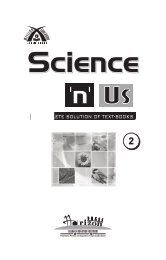
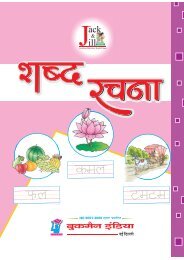


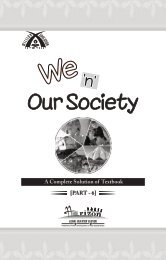
![Enjoy with Social Life-2 [26-50] - School Books Publishers India](https://img.yumpu.com/44509443/1/166x260/enjoy-with-social-life-2-26-50-school-books-publishers-india.jpg?quality=85)
